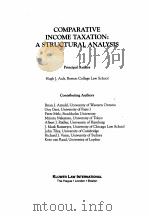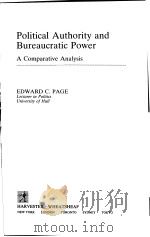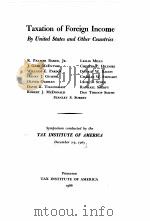《COMPARATIVE INCOME TAXATION:A STRUCTURAL ANALYSIS》
| 作者 | PRINCIPAL AUTHOR AND CONTRIBUT 编者 |
|---|---|
| 出版 | KLUWER LAW INTERNATIONAL |
| 参考页数 | 540 |
| 出版时间 | 1997(求助前请核对) 目录预览 |
| ISBN号 | 9041106014 — 求助条款 |
| PDF编号 | 813697298(仅供预览,未存储实际文件) |
| 求助格式 | 扫描PDF(若分多册发行,每次仅能受理1册) |

Introduction1
Part One: General Description5
Australia5
1. History of the income tax5
2. Composition of fiscal system6
3. Tax rates7
4. The basic structure of income tax system8
5. Statutory style10
6. Statutory interpretation12
7. Administrative, taxpayer and judicial style14
7.1 Administrative style14
7.2 Taxpayer style16
7.3 Judicial style18
8. General principles19
8.1 Relation of tax and financial accounting19
8.2 Respect for civil law form19
9. Anti-avoidance legislation21
Canada25
1. History of the income tax25
2. Constitutional issues25
3. Composition of fiscal system26
4. Tax rates26
5. Basic structure of the system27
6. Statutory style29
7. Statutory interpretation30
8. The role of the courts31
9. The Canadian self-assessment system32
10.Revenue Canada’s administrative style32
11.Taxpayers’ style32
12.Relation of tax and financial accounting34
13.Respect of civil or private law form35
14.Substance over form35
15.Anti-avoidance doctrines and legislation36
France39
1. History and basic structure of the tax system39
1.1 General outline39
1.2 The individual income taxation system39
2. Rate structure41
2.1 Individual income tax41
2.2 Corporate income tax42
3. Basic structure of the tax system42
4. Statutory style43
5. Statutory interpretation and judicial style44
6. Administrative style45
6.1 Administrative interpretations45
6.2 Tax audits46
7. Taxpayers’ style46
8. Relation of tax and financial accounting47
9. Respect for civil law47
10.Anti-avoidance doctrines and rules47
11.Tax assessment48
Germany49
1. Power to enact tax laws49
2. Sharing of tax revenue49
3. Administrating taxes50
4. Significance of taxes50
4.1 Importance of individual taxes50
4.2 Shift from direct taxes to indirect taxes53
5. Personal income tax54
5.1 Tax base54
5.2 Tax rates57
6. Corporate income tax58
7. Trade tax on income and capital59
8. Statutory style60
9. Impact of the Constitution and the Federal Constitutional Court61
9.1 Basic rights61
9.2 Important decisions61
10.Statutory interpretation62
11.Role of the courts63
12.The German assessment system63
12.1 Tax filing and audit enforcement64
12.2 Differences in tax compliance64
13.Appeals against tax assessments66
14.Appeal to court66
14.1 Federal Tax Court (Bundesfinanzhof)67
15.Administrative style67
16.Taxpayer’s style68
17.Relation of tax and financial accounting68
18.Respect of civil or private law69
19.Substance over form69
Japan71
1. History71
2. Basic structure of the system74
3. Rate structure74
4. Composition of fiscal system75
5. Statutory style75
6. Statutory interpretation76
7. Administrative style76
8. Taxpayer style77
9. Judicial role and style79
10.General principles79
10.1 Relation of tax to financial accounting79
10.2 Extent of respect for civil law form79
10.3 Anti-avoidance doctrines or legislation79
11.Procedure80
The Netherlands81
1. Tax system81
2. History of the Netherlands tax system, tax morale and tax simplification82
3. Statutory and judicial style and role 82
3.1 Statutory style83
3.2 Judicial role and style84
4. Basic structure of the income tax system85
4.1 Types of income taxes85
4.2 Sources of income86
4.3 Tax rates87
4.4 Indexation to inflation88
5. Statutory interpretation88
5.1 In general88
5.2 Respect under tax law for the civil (private) law form of contracts89
5.3 Substance over form89
6. Tax administration89
6.1 Organization of the Revenue Service91
6.2 Taxpayer bill of rights; ombudsman91
6.3 Release of Government information to taxpayers92
6.4 Advance rulings92
7. Tax procedure93
7.1 Assessment, administrative appeal and appeal to courts93
7.2 Impact of human rights conventions and EC Treaty fundamental freedom provisions94
8. International95
8.1 Historically-based foreign orientation95
8.2 Double taxation relief95
8.3 Classical system96
Sweden97
1. Historical development97
2. Basic structure97
3. Composition of fiscal system100
4. Statutory style101
5. Statutory interpretation102
6. Administrative style103
7. Taxpayer style104
8. Judicial style104
9. General principles104
9.1 Relation of tax and financial accounting105
9.2 Respect of civil law105
9.3 Anti-avoidance105
10.Procedure106
United Kingdom109
1. The principle direct taxes109
1.1 Income Tax109
1.2 Capital Gains Tax (CGT)112
1.3 Corporation Tax114
2. Indirect taxes115
3. Constitutional structure116
4. Rate of tax117
4.1 History and politics117
4.2 Inflation117
4.3 Rate structure and reliefs, 1996117
5. Tax setting117
5.1 Administration119
5.2 Avoidance of tax121
5.3 Sources of law, official practice and rulings125
6. Role of courts126
6.1 Judicial review126
6.2 Appeal system127
7. The current situation128
United States131
1. History of the federal income tax131
2. Constitutional issues132
3. Tax rates133
4. Composition of fiscal system135
5. Basic structure of income tax for individuals137
6. Basic structure of the corporate income tax142
7. Statutory style144
8. Statutory interpretation145
9. Administrative, taxpayer and judicial style147
9.1 Administrative style147
9.2 Taxpayer style148
9.3 Judicial structure and style149
10.Relationship of tax and financial accounting149
11.Anti-avoidance legislation150
12.Future developments151
Part Two: Basic Income Taxation155
Subpart A: Inclusions in the tax base155
1. Employee fringe benefits157
1.1 General157
1.2 Employer-provided pension benefits165
2. Imputed income from owner-occupied housing172
3. Gifts175
3.1 Gifts outside of a business context (“personal” gifts )176
3.2 Gifts in a business or employment context177
4. Prizes and awards178
5. Scholarships and grants180
6. Cancellation of indebtedness182
7. Gambling185
8. Illegal income186
9. Windfalls187
10.Subsidies188
11.Realization and recognition of gain189
12.Capital gains and losses194
Subpart B: Deductions204
1. Mixed business and personal expenses204
1.1 Commuting207
1.2 Moving expenses210
1.3 Clothing212
1.4 Business travel214
1.5 Business entertainment216
1.6 Child care219
2. “Hobby losses” and the criteria for determining business versus personal activities222
3. Capital costs and recovery methods225
3.1 Determining capital costs225
3.2 Capital cost recovery systems226
4. Educational costs232
5. Deduction of personal costs233
5.1 Interest233
5.2 Personal losses236
5.3 Medical expenses238
5.4 Charitable deduction239
6. Limitations on deductions and losses241
6.1 Illegal payments, fines and penalties241
6.2 Expense associated with tax-exempt income243
6.3 “Quarantining” and other limits or restrictions on certain categories of expenses245
Subpart C: Accounting250
1. Basic accounting methods250
2. Inclusion of advance payments257
3. Income treatment of deferred payments258
4. Original issue discount obligations and other complex financial instruments260
Subpart D: Attribution of income269
1. Definition of taxable unit270
2. Alimony and child support276
3. Limitations on assignment of income280
Part Three: Taxation of Business Organizations285
Subpart A: Corporate-Shareholder Taxation285
1. Overview of corporate tax systems286
2. Defining entities subject to tax289
3. Issues in corporate formation292
4. Issues involving capital structure298
5. Taxation of corporate distributions302
5.1 Basic structure of distribution rules302
5.2 Relating distributions to corporate earnings304
5.3 Constructive dividends305
5.4 Intercorporate dividends308
5.5 Distributions of appreciated or depreciated property311
5.6 Distributions involving changes in corporate structure313
5.6.1 General313
5.6.2 Stock dividends314
5.6.3 Redemptions317
6. Liquidations320
7. Corporate reorganizations and restructuring324
7.1 General324
7.2 Merger transactions325
7.3 Share exchanges331
7.4 Nonmerger asset reorganizations333
7.5 Corporate divisions: “Demergers”333
8. Transfer and limitations on transfer of corporate tax attributes340
9. Consolidated corporate taxation343
10.Special tax regimes for closely held corporations348
Subpart B: Partnership Taxation354
1. Qualification for pass-thru taxation355
2. Basic structure of pass-thru taxation356
3. Liabilities, basis and losses360
4. Transactions between partner and partnership361
5. Disposition of partnership interest363
6. Liquidation of the partnership365
Part Four: International Taxation368
Subpart A: Residence Taxation368
1. Bases for the assertion of personal taxing jurisdiction368
1.1 Individuals368
1.2 Corporations371
2. Change of status373
2.1 Change of status of individuals373
2.2 Change of status of corporations376
2.3 Dual residence379
3. Mechanisms for relief of double taxation380
3.1 Issues in the structure of a foreign taxcredit system385
3.1.1 Creditable taxes385
3.1.2 Limitations on the credit388
3.1.3 Allocation of expenses to foreign-source income391
3.1.4 Treatment of losses in the credit computation394
3.1.5 Carryover of excess credits or limitation396
3.1.6 Indirect credit for foreign taxes paid by foreign subsidiaries397
3.1.6.1 Share ownership requirements398
3.1.6.2 Tier Limitations399
3.1.6.3 Computation of the indirect credit399
3.1.7 Interaction between indirect credit and limitation system400
3.2 Issues in the structure of an exemption for foreign income402
3.2.1 Structure of the exemption402
3.2.2 Classes of exempt income402
3.2.3 Allocation of deductions to tax-exempt income406
3.2.4 Treatment of foreign losses408
4.Limitations on exemptions or deferral of income of foreign corporations409
4.1 Limitations on exemption for shareholders in foreign corporations with significant domestic share ownership411
4.2 Limitations on deferral for shareholders of foreign corporations with significant domestic share ownership413
4.3 Special provisions dealing with domestic portfolio investment in foreign investment companies422
5.Outbound transfers to foreign branches or subsidiaries425
Subpart B: Source Taxation431
1.Issues in the structure of net basis taxation of business income431
1.1 Threshold of activity431
1.2 Attribution of business income for net basis taxation434
1.3 Determination of deductions in the net basis taxation of business income439
1.4 Taxation of employment income442
1.5 Other situations involving net basis taxation444
2. Issues in the structure of gross basis taxation445
3. Branch profits tax452
4. Limitations on base-eroding payments to nonresidents452
5. Restrictions on source-based taxation of nonresidents within the European Union455
Subpart C: Additional International Topics459
1. Special international anti-avoidance rules459
2. Selected intercompany pricing issues461
3. Selected treaty issues467
3.1 Relation between domestic law and treaties; treaty override467
3.2 Approach to treaty interpretation469
3.3 Anti-treaty shopping policy471
3.4 Nondiscrimination474
3.5 “Model” treaties476
3.6 Tax sparing by treaty478
Part Five: Selected Bibliography481
Index533
1997《COMPARATIVE INCOME TAXATION:A STRUCTURAL ANALYSIS》由于是年代较久的资料都绝版了,几乎不可能购买到实物。如果大家为了学习确实需要,可向博主求助其电子版PDF文件(由PRINCIPAL AUTHOR AND CONTRIBUT 1997 KLUWER LAW INTERNATIONAL 出版的版本) 。对合法合规的求助,我会当即受理并将下载地址发送给你。
高度相关资料
-

- STRUCTURAL ANALYSIS A CLASSICAL AND MATRIX APPROACH
- 1988 COPYRIGHT
-

- COURTS A COMPARATIVE AND POLITICAL ANALYSIS
- 1981 THE UNIVERSITY OF CHICAGO PRESS
-

- FEDERAL INCOME TAXATION OF CORPORATIONS AND STOCKHOLDERS IN A NUTSHELL
- 1978 WEST PUBLISHING CO.
-

- FEDERAL INCOME TAXATION OF CORPORATIONS AND STOCKHOLDERS IN A NUTSHELL SECOND EDITION
- 1981 WEST PUBLISHING CO.
-

- FEDERAL INCOME TAXATION OF INDIVIDUALS IN A NUTSHELL SECOND EDITION
- 1978 WEST PUBLISHING CO.
-

- STRUCTURAL MECHANICS AND ANALYSIS
- 1982 VAN NOSTRAND REINHOLD COMPANY
-

- Structural analysis
- 1984 McGrawHill
-

- CENTRAL TAXATION OF INCOME IN INDIA A CRITICAL AND SUGGESTIVE STUDY
- 1986 BR.PUBLISHING CORPORATION
-

- THE TAXATION OF INCOME FOREIGN INVESTMENTS
- 1991 KLUWER LAW AND TAXATION PUBLISHERS
-

- STRUCTURAL ANALYSIS
- 1995 PWS PUBLISHING COMPANY
-

- POLITICAL AUTHOUITH AND BUREAUCRATIC POWER A COMPARATIVE ANALYSIS
- 1988 HARVESTER·WHEATSHEAF
-

- TAXATION OF FOREIGN INCOME
- 1966 TAX INSTITUTE OF AMERICA
提示:百度云已更名为百度网盘(百度盘),天翼云盘、微盘下载地址……暂未提供。➥ PDF文字可复制化或转WORD


